Animal Consumption at Hospital de San Martín (Gran Canaria): First Zooarchaeological Analysis in the Modern Era of the Canary Islands (Fifteenth-Eighteenth Centuries CE)
IF 1
3区 历史学
0 ARCHAEOLOGY
International Journal of Historical Archaeology
Pub Date : 2023-09-11
DOI:10.1007/s10761-023-00708-4
引用次数: 2
Abstract
Abstract The Canary Islands were initially colonized around 200 CE by North African Berber populations who brought with them domestic plants and animals. These communities remained isolated until the arrival of Europeans in the Late Middle Ages which triggered the conquest of the archipelago. Its geostrategic location in the framework of Atlantic expansion facilitated the arrival of people, knowledge, goods, plants, and animals which served to shape the new Canarian society. This study explores the dietary practices of this period through the zooarchaeological analysis of the faunal remains recovered at the Hospital de San Martín (fifteenth to the eighteenth centuries), Las Palmas (Gran Canaria, Spain). Our results suggest that caprines were the main taxa consumed. This follows both the pre-colonial Indigenous tradition and, according to historical sources, the subsequent European period. The faunal assemblage recovered also reveals the first directly radiocarbon-dated cases in the Canary Islands of three hitherto unknown species: cattle, chicken, and rabbit. Moreover, the results evidence a progressive increase throughout the Modern Era of chicken and rabbit, and that translocating these new species to the archipelago during the European expansion led to a diversification of meat resources.

圣医院Martín(大加那利岛)的动物消费:加那利群岛现代时期(公元15 - 18世纪)的首次动物考古学分析
加那利群岛最初是在公元200年左右被北非柏柏尔人殖民的,他们带来了家畜和植物。这些社区一直是孤立的,直到中世纪晚期欧洲人的到来引发了对群岛的征服。它在大西洋扩张框架内的地缘战略位置促进了人口,知识,货物,植物和动物的到来,这些都有助于塑造新的加那利社会。本研究通过对拉斯帕尔马斯(西班牙大加那利岛)圣医院Martín(15至18世纪)发现的动物遗骸进行动物考古分析,探讨了这一时期的饮食习惯。我们的研究结果表明,山羊是主要的消耗类群。根据历史资料,这既遵循殖民前的土著传统,也遵循随后的欧洲时期。在加那利群岛发现了三种迄今未知的动物,分别是牛、鸡和兔。此外,研究结果表明,在整个现代时期,鸡和兔的数量逐渐增加,并且在欧洲扩张期间将这些新物种转移到群岛导致了肉类资源的多样化。
本文章由计算机程序翻译,如有差异,请以英文原文为准。
求助全文
约1分钟内获得全文
求助全文
来源期刊

International Journal of Historical Archaeology
ARCHAEOLOGY-
CiteScore
2.20
自引率
12.50%
发文量
36
期刊介绍:
International Journal of Historical Archaeology is the first authoritative resource for scholarly research on this rapidly growing field. Articles - contributed by an international body of experts - contain current theoretical, methodological, and site-specific research. Exploring a wide-range of topics, articles focus on the post-1492 period and includes studies reaching into the Late Medieval period. In addition, the journal makes global connections between sites, regions, and continents.
International Journal of Historical Archaeology will fulfill the needs of archaeologists, students, historians, and historical preservationists as well as practionioners of other closely related disciplines.
For more detailed information about this new journal, including complete submission instructions, please visit the http://www.ilstu.edu/~ceorser/ijha.html International Journal of Historical Archaeology Web Site. Rated ''A'' in the European Reference Index for the Humanities (ERIH)
International Journal of Historical Archaeology is rated ''A'' in the ERHI, a new reference index that aims to help evenly access the scientific quality of Humanities research output. For more information visit http://www.esf.org/research-areas/humanities/activities/research-infrastructures.html Rated ''A'' in the Australian Research Council Humanities and Creative Arts Journal List. For more information, visit: http://www.arc.gov.au/era/journal_list.htm
 求助内容:
求助内容: 应助结果提醒方式:
应助结果提醒方式:


